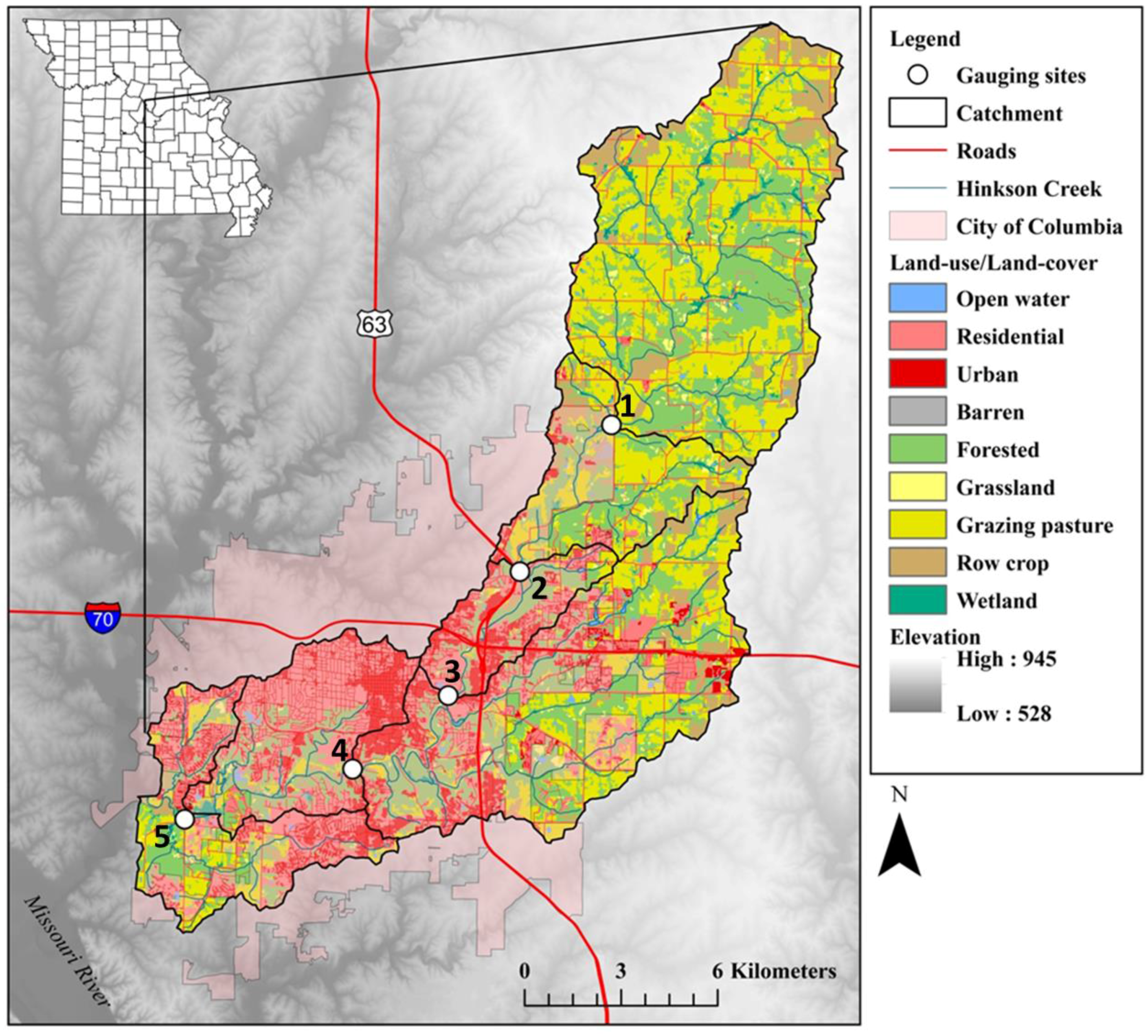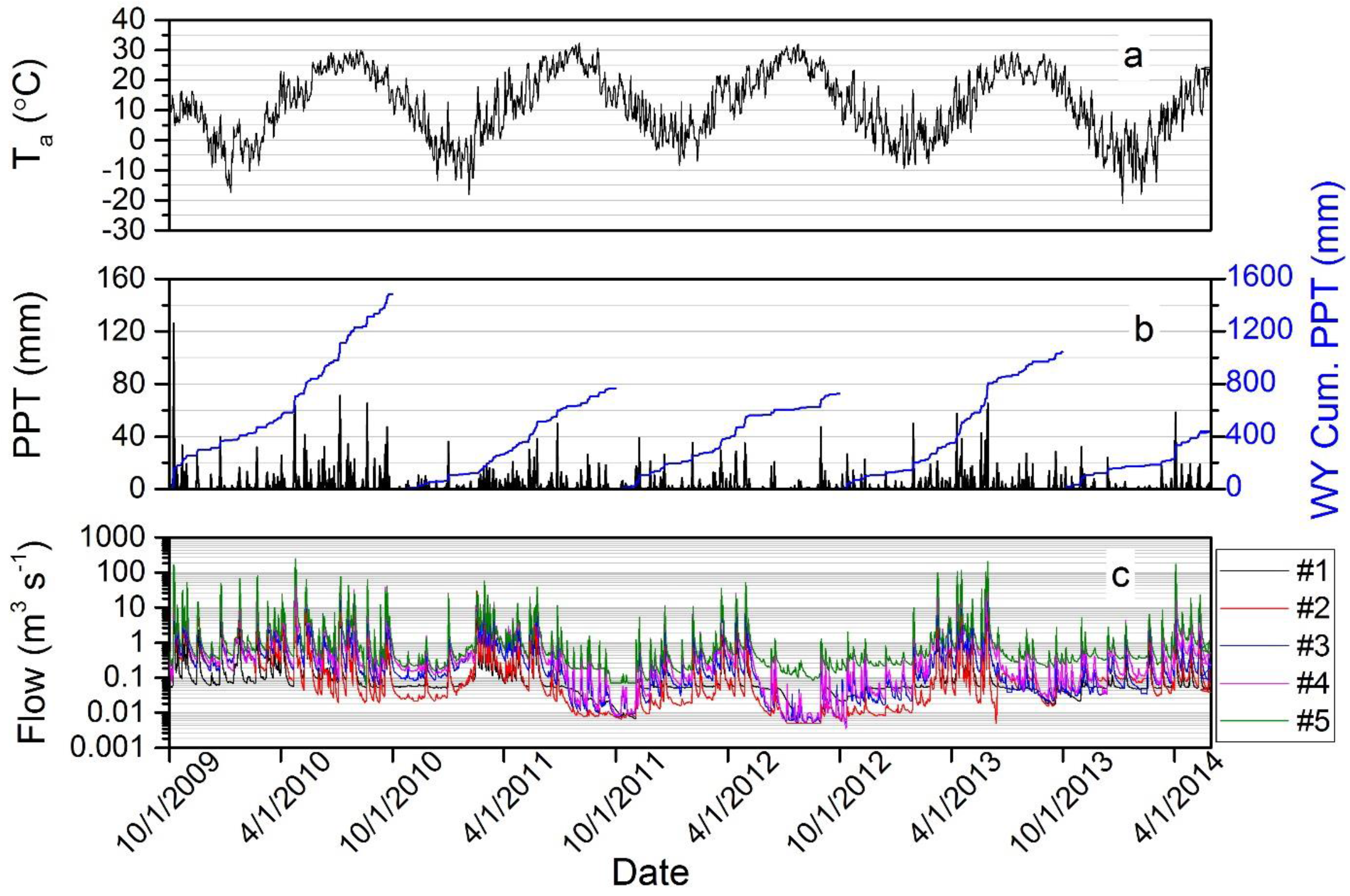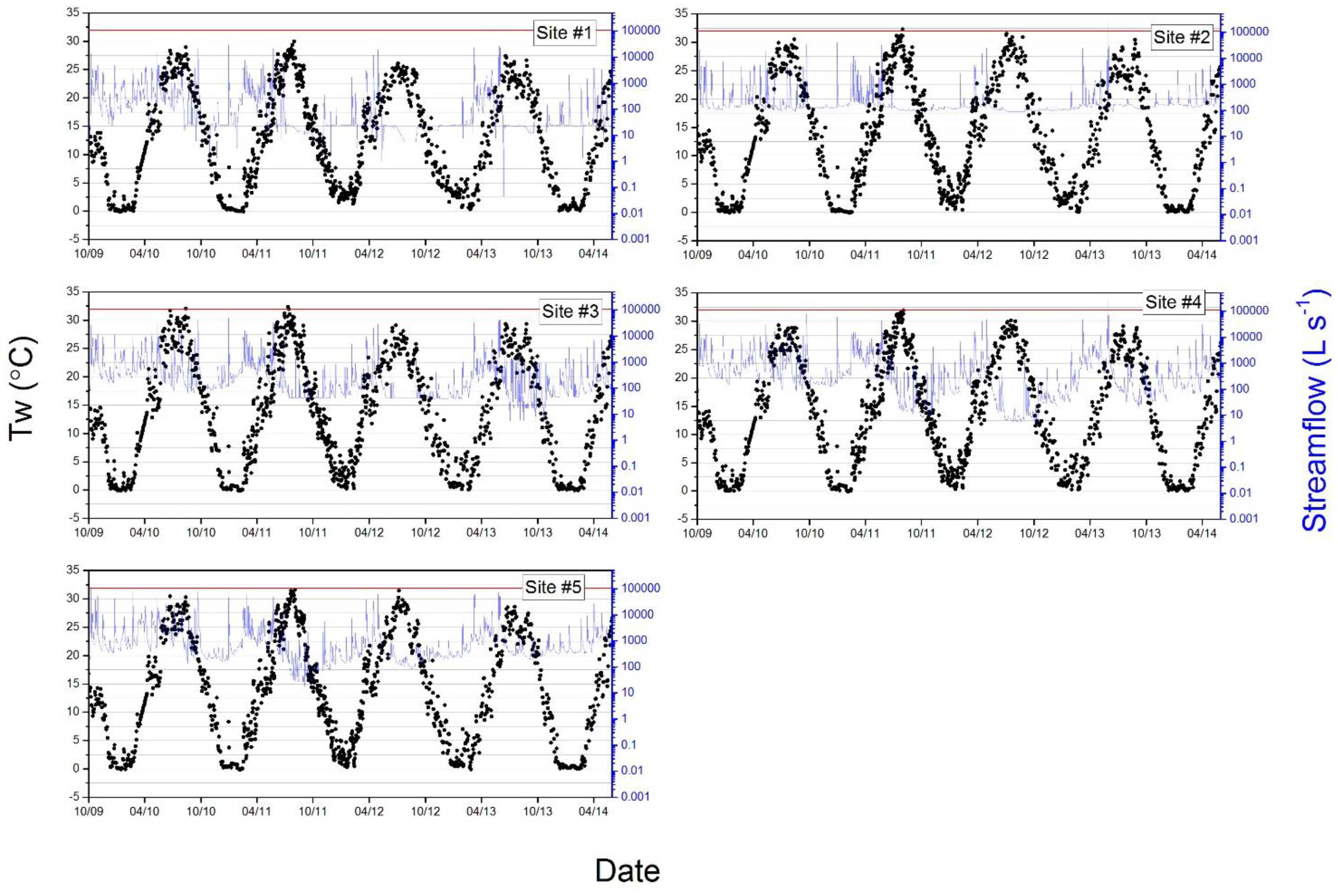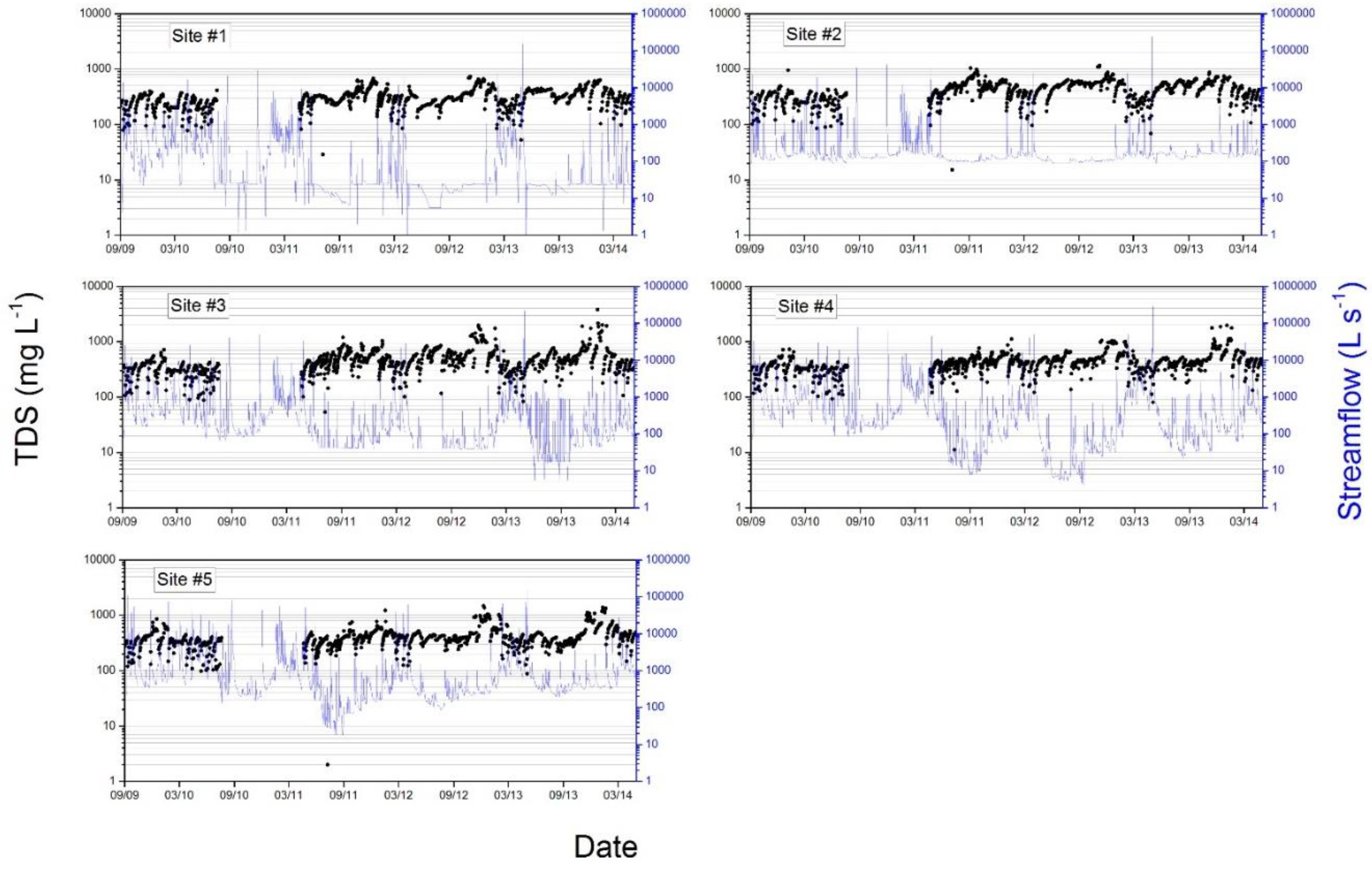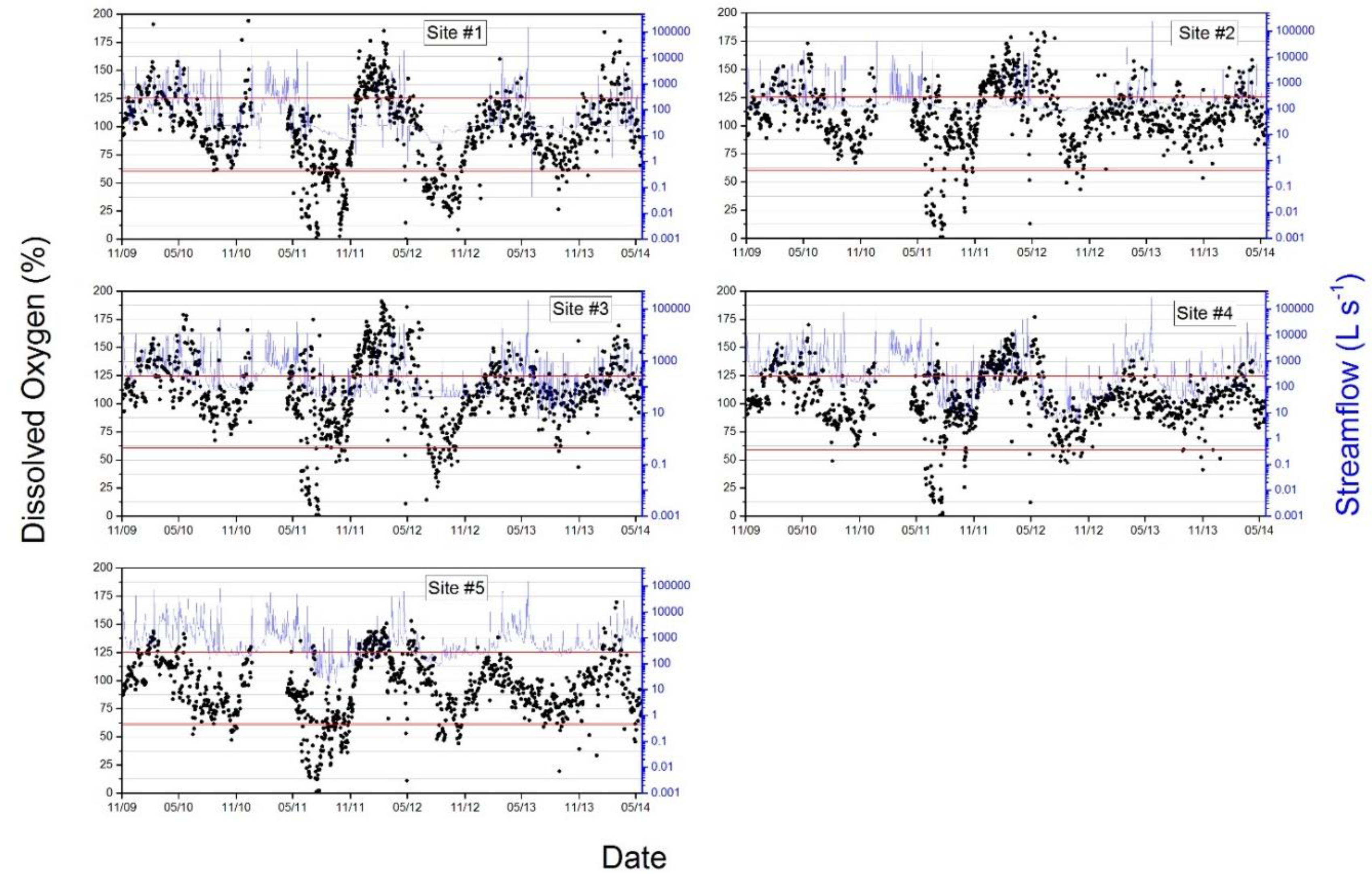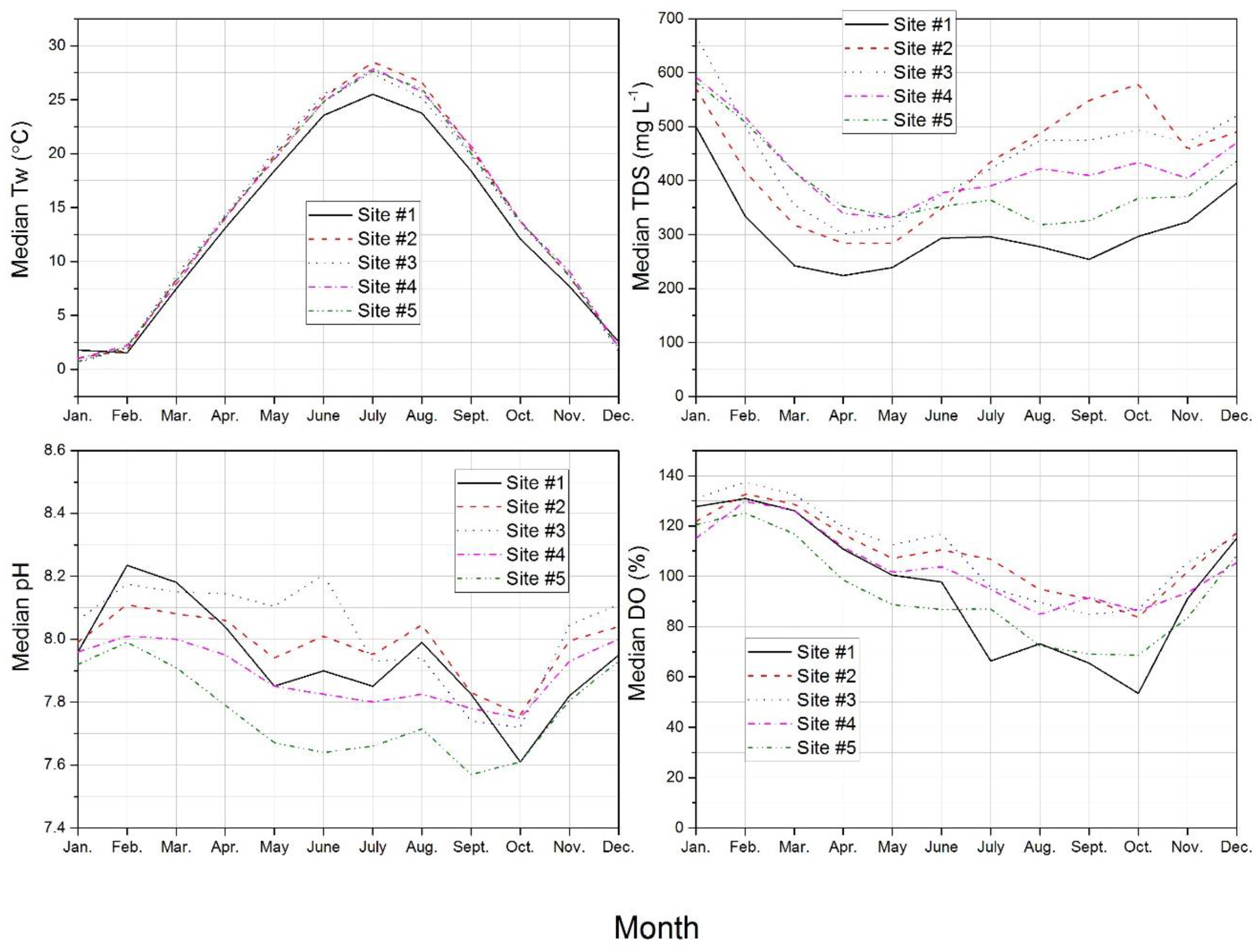3.1. Stream Physiochemical Parameters
Wilcoxon signed rank results showed significant differences (
p < 0.01) between water temperatures for every site pairing. Although air temperature was greatest at site #3 (e.g., highest average, maximum, and minimum) (
Table 3), site #2 displayed the highest average, median, maximum (i.e., with site #3), and standard deviation of water temperature, relative to the other monitoring sites (
Table 4). Conversely, the lowest average, median, maximum, and standard deviation of water temperature were observed at site #1. Water temperatures tracked air temperatures (
Figure 2 and
Figure 3), with highs and lows observed during the summers and winters, respectively. Notably, maximum temperatures at sites #2 and #3 exceeded the maximum allowable water temperature (32.2 °C) established by the Missouri Department of Natural Resources for “warm water habitats” [
47], a threshold for potential fish mortality [
33]. As opposed to a consistent spatial trend (e.g., increasing or decreasing), or the absence of a definable spatial trend (e.g., statistical similarity), water temperature regimes in HCW are apparently characterized by a threshold/step-change condition, with an upshifted (e.g., higher average, median, and maximum temperatures) and more variable (e.g., greater standard deviation) regime incident at site #2, relative to site #1, which is propagated downstream through the watershed. Given sub-watershed #2 contains the upper portions of the city of Columbia, and is characterized by a 100% increase in urban and developed land uses compared to sub-watershed #1 (
Table 1), it is possible that urbanization and the removal of riparian canopy are primary drivers of water temperature regime in HCW, a hypothesis supported by the findings of Zeiger et al. [
33].
Statistical test results showed significant differences (
p < 0.01) between total dissolved solids (TDS) for every site pairing, except sites #2 and #4 (
p > 0.5). TDS regimes at all sites displayed seasonality (see below), with maximum concentrations observed during winter months (i.e., 12/8/2012 for sites #1 and #2, 1/29/2014, 2/1/2014, and 1/7/2013 for sites #3, #4, and #5, respectively), and minimum concentrations observed following low-intensity summer precipitation events (i.e., 8/6/2011 for sites #1, #2, and #3, and 8/8/2011 and 8/7/2011 for sites #4 and #5, respectively) (
Figure 4). Highest average, median (i.e., with site #2), maximum, minimum, and standard deviation of TDS were observed at site #3 (i.e., mixed-use urban). Whereas lowest average, median, maximum, and standard deviation of TDS were observed at site #1, the lowest minimum was observed at site #5 (
Table 4). Given watershed land use characteristics, increasing TDS from site #1 (agriculture) to #3 (mixed-use urban) could be related to an increase in urban land cover (
Table 1). Interestingly, the general spatial rend of TDS (i.e., increasing from site #1 to #3, and decreasing from site #3 to #5), contrasts with that reported by Zeiger and Hubbart [
24], who noted an opposite spatial trend (i.e.,
decreasing from site #1 to #3, and
increasing from site #3 to #5) for suspended sediment concentrations in Hinkson Creek. The decrease in TDS concentration from site #3 (mixed-use urban) to #5 (suburban), also contrasts with results of works from separate mixed-land-use watersheds [
10,
14], which reported increasing solute concentrations in the downstream direction. The decreasing spatial trend coupled with streamflow results (
Table 3), may suggest the contribution of dilution processes to the physiochemical regime of Hinkson Creek below site #3. While dilution processes may only be “masking” water quality degradation in the lower watershed (e.g., increased loading despite decreased concentration), results nonetheless indicate attenuation of relatively high TDS observed at site #3.
Statistical analyses indicated significant differences (
p < 0.01) between pH for every site pairing. Highest average, median, and minimum pH were observed at site #3, while the highest maximum value was observed at site #1 (
Table 4). Average, median, and maximum values indicate alkaline water at each monitoring site. However, minimum values indicate the irregular occurrence of slightly acidic conditions. Importantly, pH maximums at each site exceeded the water quality standard of 9.0 established by the Missouri Department of Natural Resources [
47]. Likewise, pH minimums at sites #1 and #2 exceeded the recommended minimum of 6.5, a threshold also approached by sites #4 and #5 [
47]. However, maximum and minimum pH thresholds were only exceeded a few times during the study (
Figure 5). Similar to TDS, pH regimes displayed seasonality at each site, with higher values during the winter, and lowest values observed during late summer/early fall. Moreover, the spatial trend of average and median pH was similar to that of TDS, with increasing values from site #1 to #3, and decreasing values from site #3 to #5.
Statistical test results showed significant differences (
p < 0.01) between dissolved oxygen (DO) for every site pairing. Highest average, and median DO were observed at site #3, as was lowest minimum. However, maximum DO was observed at site #1 (
Table 4). DO descriptive statistics displayed a similar spatial trend as TDS and pH, with average and median values increasing from site #1 to #3, and decreasing from site #3 to #5 (
Figure 6 and
Figure 7). Furthermore, DO displayed a similar seasonality at each site, with higher values during the winter, and lower values during late summer/early fall. Notably, DO measurements at all monitoring sites frequently exceeded water quality standards (i.e., minimum = 60% of saturation, maximum = 125% of saturation) established by the Missouri Department of Natural Resources [
47,
48]. DO observations were below the recommended minimum a total of 153, 46, 65, 51, and 121 times at sites #1–5, respectively. Likewise, DO observations exceeded the recommended maximum a total of 204, 290, 331, 221, and 137 times at sites #1–5, respectively. Therefore, over the course of the study, stream conditions were observed in excess of established DO-related water quality standards on 35, 33, 38, 26, and 25% of days at sites #1–5, respectively, or 31% on average. Thus, results suggest the potential for DO-related stress on aquatic biota in Hinkson Creek. Specifically, results indicate a high frequency of hypoxic conditions at sites #1 and #5, and a high frequency of super-saturated conditions at sites #2–4. It is notable that site #1 displayed such a high frequency of DO standard exceedance, given less development in sub-watershed #1 relative to other sites (
Table 1). However, the sub-watershed includes 36% forested land cover and approximately 60% agricultural land uses. Agricultural land uses have previously been shown to negatively impact DO regimes and alter stream metabolism via nutrient loading, hydrological alteration, and riparian canopy reduction [
20,
49,
50]. A previous work conducted in HCW [
50] reported significantly (
p < 0.01) higher nutrient concentrations (i.e., nitrate, ammonia, total inorganic nitrogen, and total phosphorus) at site #1 relative to all other sites. Thus, given observed DO trends, results of the current work suggest that agriculture-induced water quality degradation in the headwaters catchment are propagating downstream in Hinkson Creek. Given the spatial extent of DO issues in Hinkson Creek, results should challenge common expectations regarding the success of de-listing efforts in this and similar systems, and investments aimed at restoring contemporary mixed-use watersheds to fully-supportive aquatic ecosystems.
3.2. Physiochemical Parameter Seasonality and Correlation Results
Among the four parameters studied, correlations were strongest between DO and water temperature, an expected result given the established functional relationship of the two variables [
51]. Spearman correlation coefficient (SCC) values were –0.77, –0.78, –0.78, –0.82, and –0.78 for sites #1–5, respectively; and each site displayed a statistically significant (
p < 0.05) relationship. Results for DO and TDS were more varied, with statistically significant (
p < 0.05) positive relationships identified at sites #1 (SCC = 0.35), #3 (SCC = 0.17), #4 (SCC = 0.38), and #5 (SCC = 0.54). Statistically significant (
p < 0.05) positive relationships were found between DO and pH at all sites, with SCC values equal to 0.40, 0.32, 0.45, 0.45, and 0.60, for sites #1–5, respectively. Negative relationships between TDS and water temperature were significant (
p < 0.05) at all sites, with SCC values equal to –0.37, –0.24, –0.37, –0.45, and –0.54, for sites #1–5, respectively.
Physiochemical parameters displayed contrasting relationships with streamflow (
Table 5). For example, statistically significant correlations (
p < 0.05) were identified between DO and streamflow at every site, with SCC values equal to 0.54, 0.27, 0.30, 0.31, and 0.19, for sites #1–5, respectively. Likewise, Tw and TDS showed significant relationships with streamflow at every site. However, SCC values were lower than 0.6 for every pairing, indicating relatively weak relationships. Significant relationships were only observed between pH and streamflow at sites #1 and #4. Collectively, the weakness of SCC values suggests streamflow has a limited influence on physiochemical temporal variability.
Results indicated seasonal trends for each of the four physiochemical parameters studied (
Figure 8). For example, when comparing observations from the cold (i.e., November–April) and warm (i.e., May–October) seasons, five-site-median TDS was 9% greater during the cold season. Similarly, five-site-median pH was 2% greater and five-site-median DO was 75% greater during the cold season than the warm season. The most obvious factor likely contributing to physiochemical parameter seasonality, both directly and indirectly, is air temperature, which displays the same sinusoidal annual trend as water temperature [
52] (
Figure 2 and
Figure 3). Given DO saturation is an inverse function of water temperature [
51], the influence of air temperature can be understood to extend to DO regime. However, as illustrated by
Figure 8, the DO temporal trend in Hinkson Creek does not cleanly follow that of water temperature. For example, while peak monthly median water temperature (e.g., median of all water temperature measurements conducted in every January of the study) was observed at all sites in July, DO monthly median minimums were not observed until September or October, suggesting a time lag of 2–3 months. Instead, the general DO temporal trend appears to track that of pH more closely.
Higher pH and TDS during the cold season is reasonable given the widespread practice of road salt application in HCW during the cold season. Hubbart et al. [
43] reported acutely (i.e., >860 mg L
−1) and chronically (i.e., > 230 mg L
−1) toxic chloride concentrations in Hinkson Creek, positively related to urban land use, with seasonal peaks during late winter/early spring melting periods, attributable to road salt application. However, the practice does not explain subsequent peaks in summer and fall for pH and TDS, respectively, or the decrease in pH observed at all sites during October (
Figure 8). Rather, pH, TDS, and DO appear to variably track the growing season, which extends from April to October in central Missouri. Several mechanisms could explain such observed trends. For example, terrestrial and aquatic primary productivity could contribute to increasing TDS during the growing season (
Figure 8) via continuous loading of detritus, which could compose a substantial fraction of TDS. Likewise, leaf-off typically occurs during October and November, and the mineralization of organic matter is understood to lower in-stream pH by contributing acidic compounds to the water column [
53], thus positively influence TDS and negatively influence DO concentrations. Furthermore, in-stream autotrophic photosynthesis is known to positively impact both DO and pH; the former through addition of oxygen to the water column, and the latter via consumption of CO
2, which in turn can lead to dissociation of bicarbonate molecules to fulfill in-stream carbon equilibrium [
54]. Autotrophic photosynthesis has been cited previously as a factor contributing to DO and pH diel cycles [
15,
54,
55], but results of the current work suggest the influence of the process on seasonal cycles as well.
Correlation results supply additional evidence regarding mechanisms potentially contributing to observed physiochemical regime. For example, the significant, negative relationships between TDS and water temperature at each site is likely attributable to the processes discussed above, namely road salt application [
43] and organic detritus loading (e.g., mineralization of leaf litter), that contribute to consistently higher TDS during the cold season. However, variable TDS/DO relationships are likely the result of covariation with water temperature. Given the practice of road salt application, the same could be true of pH/DO relationships. To investigate whether significant, positive relationships between pH and DO were merely a result of covariation with water temperature, pH observations corresponding (i.e., sampling date/time) to observations of DO super-saturation (i.e., >125%) were compared to those corresponding to hypoxic conditions (DO < 60%). Mann Whitney test results indicated significant differences (
p < 0.05) at each monitoring site, with median super-saturation pH measurements (avg. = 8.1) higher than median hypoxia pH measurements (avg. = 7.8). However, more importantly, results of seasonal analyses indicated super-saturation and hypoxia observations occurred during both the warm and cold seasons (
Figure 6), thus suggesting the influence of a factor other than water temperature. As previously discussed, a likely explanation is in-stream vegetation processes (e.g., autotrophic photosynthesis), which could help explain covariation of DO and pH. Furthermore, recent studies have noted that autotrophic photosynthesis can continue throughout the warm and cold seasons in temperate streams [
56,
57,
58,
59,
60], thus contributing to super-saturation observations in both seasons. The current work did not include investigation of stream metabolic processes, thereby providing direction for future mechanistic studies. Collectively, results highlight the interacting and competing influences of natural (e.g., climate, vegetation) and anthropogenic (e.g., road salt application) factors on the physiochemical regime of Hinkson Creek.
Correlation results did not indicate statistically significant relationships between physiochemical parameters and LULC metrics (e.g., percentage agriculture, urban, or forest cover). However, the result is to be expected given only five monitoring sites (i.e., five pairs of correlation data points) were included in the study design. Regardless, relationships merit reporting. For example, study median pH displayed a relatively strong, positive relationship (SCC = 0.70) with cumulative watershed (i.e., upstream) percentage forest cover, a reasonable result given the negative impact of leaf litter on stream pH [
53]. However, DO displayed poor relationships (i.e., R
2 ≤ 0.5) with all LULC metrics, illustrating the complicated set of factors influencing DO regimes.
3.3. Multivariate DO Modeling
Given statistically significant (
p < 0.05) correlation results, physiochemical parameter data were used to construct multivariate DO models for each monitoring site (
Table 6). Models produced generally good DO estimates, with R
2 (i.e., actual vs. predicted DO) values of approximately 0.7 and Normalized Root Mean Squared Error (NRMSE) values ranging from 21–28%. Model fit was optimized by including all four potentially contributing factors (i.e., water temperature, pH, TDS, and flow) for sites #2, #3, and #5. The optimal model for site #1 did not include flow, while the optimal model for site #4 did not include TDS. However, it is important to note that for all sites, including TDS and/or flow in models only marginally improved R
2 and NRMSE values. For example, R
2 values for DO models utilizing just water temperature and pH as independent variables were 0.71, 0.70, 0.74, 0.71, and 0.73 for sites #1–5, respectively, nearly equal to optimized model values reported in
Table 6. Similarly, NRMSE values for the two factor models were 28, 21, 22, 21, and 24% for sites #1–5, respectively, equal to those for the four factor models. Notably, inclusion of pH improved model performance, as compared to a one factor water temperature model. R
2 values for DO models utilizing only water temperature were 0.60, 0.60, 0.61, 0.66, and 0.65 for sites #1–5, respectively; and NRMSE values were 33, 24, 27, 22, and 27% for sites #1–5, respectively. Therefore, despite improvements of model performance by inclusion of TDS and/or flow, results indicate a simplified two factor model (i.e., water temperature and pH) is capable of producing similarly accurate DO estimates.
3.4. Study Implications
Collectively, results highlight the interacting and competing influences of natural and anthropogenic factors on the physiochemical regime of contemporary mixed-land-use watersheds. For example, observed TDS, pH, and DO regimes suggest road salt application, seasonal detritus loading, and in-stream autotrophic photosynthesis as likely driving forces. Considering high TDS, pH, and water temperature, and the highest frequency of DO criteria exceedance, results indicate sub-watershed #3 (mixed-use urban) is specifically prone to poor water quality (
Table 4). Spatial trends of water quality and streamflow data suggest site #3 is a problematic location (i.e., stream reach/sub-watershed), where water quality issues (e.g., TDS) are accumulating from upstream, but where streamflow is insufficient to attenuate land use impacts, as is likely the case for sub-watersheds #4 and #5 (suburban). Results complement those of Hubbart et al. [
43], who reported a high frequency of observed acute and chronic chloride toxicity in sub-watershed #3, attributable to road salt application. Moreover, DO spatial trends suggest the possibility that agriculture-driven water quality degradation in the headwaters catchment is propagating downstream. When considered in the context of findings from the current work, results pose serious questions regarding the feasibility of urban stream restoration. For example, barring a complete reorganization of the HCW landscape, and the discontinuation of public safety practices (e.g., road salt application), work such as that presented here should bring to question whether mid-watershed reaches of Hinkson Creek (or other physiographically similar watersheds) can be restored to a fully-supportive aquatic ecosystem, given the complex set of interacting natural and anthropogenic factors influencing the water quality regime. Furthermore, results illustrate the complicated nature of water quality regimes in mixed-land-use watersheds and illustrate the number of natural and anthropogenic factors that must be accounted for in order to maximize efficacy of management and restoration efforts. Such questions and issues must be duly considered by managers, stakeholders, and regulatory agencies in order to realistically improve the 303(d) listing process and more effectively steward natural and financial resources.
The experimental watershed method is a globally transferrable model that can be adopted by urban communities to guide current and future resource management practices, better target locations for remediation efforts, and evaluate the long-term efficacy and outcomes of management strategies. For example, in the current work, application of the method effectively identified problematic regions within the watershed (e.g., sub-watershed #3) that should be targeted for subsequent mitigation efforts, or barring the ability to successfully restore the reach, should be considered for 303(d) de- or re-listing. Bracketing stream reaches during assessment can enable managers and stakeholders to more effectively target water quality remediation investments within the watershed, thereby improving outcome success of ongoing management efforts.
Results of the current work indicate that in a contemporary, urbanizing watershed of the temperate U.S., a simple two factor model utilizing water temperature and pH can generate reliable DO estimates. While previous studies have established that DO regimes are variably influenced by additional physiochemical (e.g., TDS, streamflow, solar radiation budgets) and biochemical (e.g., in-stream photosynthesis/respiration) parameters, direct measurement of such factors can be expensive and time intensive. Thus, a more simplified approach incorporating fewer observed data, could provide scientists and practitioners with a useful site-specific option to improve the prediction, and thereby the management, of DO regimes versus traditional water temperature models. However, evaluation of the transferability of the modeling method will require similar work to be conducted in physiographically contrasting regions.
